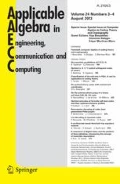Abstract
Linear codes with complementary duals, shortly named LCD codes, are linear codes whose intersection with their duals is trivial. In this paper, we outline a construction for LCD codes over finite fields from the adjacency matrices of two-class association schemes. These schemes consist of either strongly regular graphs (SRGs) or doubly regular tournaments (DRTs). Under certain conditions, the method yields formally self-dual codes. Further, we propose a decoding algorithm that can be feasible for the LCD codes obtained using one of the given methods.
Similar content being viewed by others
Availability of data and material
Not applicable.
Code availability
Not applicable.
References
Alahmadi, A., Altassan, A., AlKenani, A., Çalkavur, S., Shoaib, H., Solé, P.: A multisecret-sharing scheme based on LCD codes. Mathematics 8(2), 272 (2020)
Alahmadi, A., Deza, M., Sikirić, M.D., Solé, P.: The joint weight enumerator of an LCD code and its dual. Discrete Appl. Math. 257, 12–18 (2019)
Araya, M., Harada, M.: On the classification of linear complementary dual codes. Discrete Math. 342, 270–278 (2019)
Assmus, E.F., Key, J.D.: Designs and their Codes. Cambridge University Press, Cambridge (1992)
Bosma, W., Cannon, J.: Handbook of Magma Functions, Department of Mathematics, University of Sydney, (1994). http://magma.maths.usyd.edu.au/magma
Carlet, C., Guilley, S.: Complementary dual codes for counter-measures to side-channel attacks. Adv. Math. Commun. 10, 131–150 (2016)
Carlet, C., Mesnager, S., Tang, C., Qi, Y.: Linear codes over \(F_q\) which are equivalent to LCD codes. IEEE Trans. Inform. Theory 64, 3010–3017 (2018)
Crnković, D., Egan, R., Rodrigues, B.G., Švob, A.: LCD codes from weighing matrices. Appl. Algebra Eng. Commun. Comput. (2019). https://doi.org/10.1007/s00200-019-00409-8
Crnković, D., Mikulić, V.: Self-orthogonal doubly-even codes from Hadamard matrices of order 48. Adv. Appl. Discrete Math. 1, 159–170 (2008)
Delsarte, P.: An algebraic approach to the association schemes of coding theory. Philips Res. Reports Suppl. 10, (1973)
Dougherty, S.T., Kim, J.-L., Solé, P.: Double circulant codes from two-class association schemes. Adv. Math. Commun. 1, 45–64 (2007)
Gaborit, P.: Quadratic double circulant codes over fields. J. Combin. Theory Ser. A 97, 85–107 (2002)
Grassl, M.: Bounds on the minimum distance of linear codes and quantum codes, http://www.codetables.de. Accessed (20 January 2020)
Harada, M., Saito, K.: Binary linear complementary dual codes. Cryptogr. Commun. 11, 677–696 (2019)
Higman, D.G.: Coherent configuration. Geom. Dedicata 4, 1–32 (1975)
Horiguchi, N., Nakasora, H., Wakabayashi, T.: On the strongly regular graphs obtained from quasi-symmetric 2-(31,7,7) designs. Bull. Yamagata Univ. Natur. Sci. 16, 1–6 (2005)
Huffman, W.C., Pless, V.: Fundamentals of Error-Correcting Codes. Cambridge University Press, Cambridge (2003)
Kennedy, G.T., Pless, V.: On designs and formally self-dual codes. Des. Codes Cryptogr. 4, 43–55 (1994)
Key, J.D., Rodrigues, B.G.: Special LCD codes from Peisert and Generalized Peisert Graphs. Graphs Combin. 35, 633–652 (2019)
Koukouvinos, C.: http://www.math.ntua.gr/~ckoukouv/. Accessed (20 January 2020)
Massey, J.L.: Linear codes with complementary duals. Discrete Math. 106(107), 337–342 (1992)
Qian, L., Shi, M., Solé, P.: On self-dual and LCD quasi-twisted codes of index two over a special chain ring. Cryptogr. Commun. 11, 717–734 (2019)
Reid, K.B., Brown, E.: Doubly regular tournaments are equivalent to skew Hadamard matrices. J. Combin. Theory Ser. A 12, 332–338 (1972)
Sendrier, N.: Linear codes with complementary duals meet the Gilbert-Varshamov bound. Discrete Math. 304, 345–347 (2004)
Sok, L., Shi, M., Solé, P.: Constructions of optimal LCD codes over large finite fields. Finite Fields Appl. 50, 138–153 (2018)
Shi, M., Zhu, H., Qian, L., Sok, L., Solé, P.: On self-dual and LCD double circulant and double negacirculant codes over Fq+uFq. Cryptogr. Commun. 12, 53–70 (2020)
Shi, M., Huang, D., Sok, L., Solé, P.: Double circulant LCD codes over \(Z_4\). Finite Fields Appl. 58, 133–144 (2019)
Stoichev, S.D.: The nonisomorphism of the strongly regular graphs derived from the quasi-symmetric 2-(31,7,7) designs. C. R. Acad. Bulgare Sci. 40, 33–35 (1987)
Tonchev, V.D.: Quasi-symmetric 2-(31,7,7) designs and a revision of Hamada’s conjecture. J. Comb. Theory Ser. A 42, 104–110 (1986)
Wu, R., Shi, M.: A modified Gilbert-Varshamov bound for self-dual quasi-twisted codes of index four. Finite Fields Appl. 62, 101627 (2020)
Acknowledgements
The authors thank the anonymous referees for helpful suggestions that improved the paper.
Funding
This work has been fully supported by Croatian Science Foundation under the project 6732.
Author information
Authors and Affiliations
Contributions
This is a joint collaboration with all three authors contributing substantially throughout.
Corresponding author
Ethics declarations
Conflicts of interest/Competing interests
The authors declare no conflict of interest.
Additional information
Publisher's Note
Springer Nature remains neutral with regard to jurisdictional claims in published maps and institutional affiliations.
Rights and permissions
About this article
Cite this article
Crnković, D., Grbac, A. & Švob, A. Formally self-dual LCD codes from two-class association schemes. AAECC 34, 183–200 (2023). https://doi.org/10.1007/s00200-021-00497-5
Received:
Revised:
Accepted:
Published:
Issue Date:
DOI: https://doi.org/10.1007/s00200-021-00497-5


